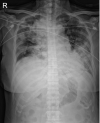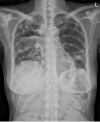Lemierre's syndrome caused by Klebsiella pneumoniae: A case report
- PMID: 34631480
- PMCID: PMC8477271
- DOI: 10.5527/wjn.v10.i5.101
Lemierre's syndrome caused by Klebsiella pneumoniae: A case report
Abstract
Background: Lemierre's syndrome is a disease that causes anaerobic sepsis, internal jugular vein thrombosis, and septic embolism in the lungs and other organs after acute oropharyngeal infection. It was named after André-Alfred Lemierre in 1936.
Case summary: Here, we have reported a case of Lemierre's syndrome in a 56-year-old female patient who presented with a sore throat. The patient had septic shock, had not voided, and had severe hyperglycemia at the time of her visit. Imaging tests revealed bilateral pneumonia, pleural effusion, pulmonary embolism, and renal vein thrombosis. The patient was admitted to the intensive care unit and placed on mechanical ventilation due to acute respiratory distress syndrome. Continuous renal replacement therapy was administered to treat renal failure with anuria. Klebsiella pneumoniae was cultured from blood and sputum samples. After reviewing various results, the patient was ultimately diagnosed with Lemierre's syndrome. The patient was treated with appropriate antibiotics and thrombolytic agents. She was discharged from the hospital after recovery.
Conclusion: Lemierre's syndrome is associated with a high mortality rate. Therefore, clinicians should be familiar with the signs and symptoms of this disease as well as the preemptive examinations, procedures, and treatments.
Keywords: Case report; Diabetes Mellitus; Klebsiella pneumoniae; Lemierre's syndrome; Pulmonary embolism; Septic pneumonia.
©The Author(s) 2021. Published by Baishideng Publishing Group Inc. All rights reserved.
Conflict of interest statement
Conflict-of-interest statement: None of the authors have any financial or other conflicts of interest to declare with regard to this manuscript.
Figures




Similar articles
-
Lemierre's Syndrome Caused by Klebsiella pneumoniae: A Case Report and Literature Review.Cureus. 2023 Aug 31;15(8):e44434. doi: 10.7759/cureus.44434. eCollection 2023 Aug. Cureus. 2023. PMID: 37664341 Free PMC article.
-
Lemierre's Syndrome Caused by Klebsiella pneumoniae in a Diabetic Patient: A Case Report and Review of the Literature.Hawaii J Med Public Health. 2015 Aug;74(8):260-6. Hawaii J Med Public Health. 2015. PMID: 26279962 Free PMC article. Review.
-
Multiple Cranial Nerve Palsies in a Pediatric Case of Lemierre's Syndrome due to Streptococcus viridans.Case Rep Neurol Med. 2021 Oct 26;2021:4455789. doi: 10.1155/2021/4455789. eCollection 2021. Case Rep Neurol Med. 2021. PMID: 34745672 Free PMC article.
-
A case of blindness caused by Lemierre's syndrome.Clin Case Rep. 2023 Dec 13;11(12):e8327. doi: 10.1002/ccr3.8327. eCollection 2023 Dec. Clin Case Rep. 2023. PMID: 38094142 Free PMC article.
-
Lemierre's syndrome: A forgotten and re-emerging infection.J Microbiol Immunol Infect. 2020 Aug;53(4):513-517. doi: 10.1016/j.jmii.2020.03.027. Epub 2020 Apr 4. J Microbiol Immunol Infect. 2020. PMID: 32303484 Review.
Cited by
-
Lemierre's Syndrome Due to Klebsiella pneumoniae Results in Pulmonary Abscess Complications in a Patient With Diabetes: A Rare Case Report.Case Rep Infect Dis. 2024 Dec 23;2024:8176530. doi: 10.1155/crdi/8176530. eCollection 2024. Case Rep Infect Dis. 2024. PMID: 39741700 Free PMC article.
-
Lemierre's Syndrome: A Comeback Story.Cureus. 2022 Jun 11;14(6):e25843. doi: 10.7759/cureus.25843. eCollection 2022 Jun. Cureus. 2022. PMID: 35832767 Free PMC article.
-
Lemierre's Syndrome Caused by Klebsiella pneumoniae: A Case Report and Literature Review.Cureus. 2023 Aug 31;15(8):e44434. doi: 10.7759/cureus.44434. eCollection 2023 Aug. Cureus. 2023. PMID: 37664341 Free PMC article.
-
Lemierre's syndrome associated-diabetic ketoacidosis in an elderly female: a case report.BMC Infect Dis. 2024 Oct 10;24(1):1137. doi: 10.1186/s12879-024-10033-8. BMC Infect Dis. 2024. PMID: 39390399 Free PMC article.
-
Lemierre's syndrome: A rare complication of acute bacterial pharyngitis.S Afr J Infect Dis. 2024 Apr 9;39(1):606. doi: 10.4102/sajid.v39i1.606. eCollection 2024. S Afr J Infect Dis. 2024. PMID: 38726019 Free PMC article.
References
-
- Martínez JA, Horcajada JP, Almela M, Marco F, Soriano A, García E, Marco MA, Torres A, Mensa J. Addition of a macrolide to a beta-lactam-based empirical antibiotic regimen is associated with lower in-hospital mortality for patients with bacteremic pneumococcal pneumonia. Clin Infect Dis . 2003;36:389–395. - PubMed
-
- Sinave CP, Hardy GJ, Fardy PW. The Lemierre syndrome: suppurative thrombophlebitis of the internal jugular vein secondary to oropharyngeal infection. Medicine . 68:85–94. - PubMed
-
- Kuppalli K, Livorsi D, Talati NJ, Osborn M. Lemierre's syndrome due to Fusobacterium necrophorum. Lancet Infect Dis . 2012;12:808–815. - PubMed
Publication types
LinkOut - more resources
Full Text Sources

